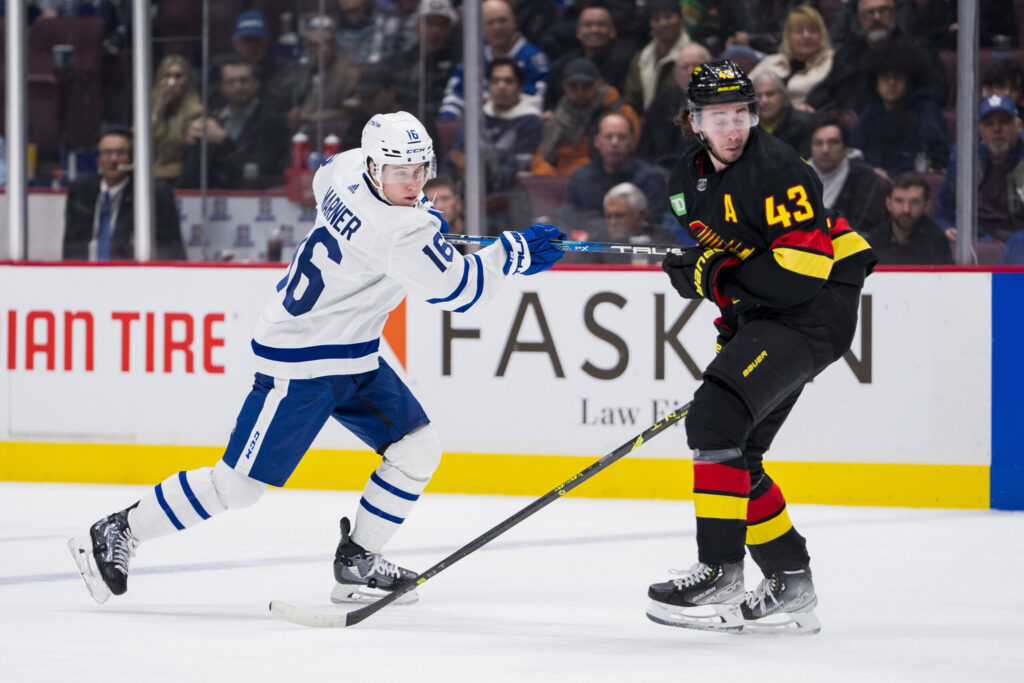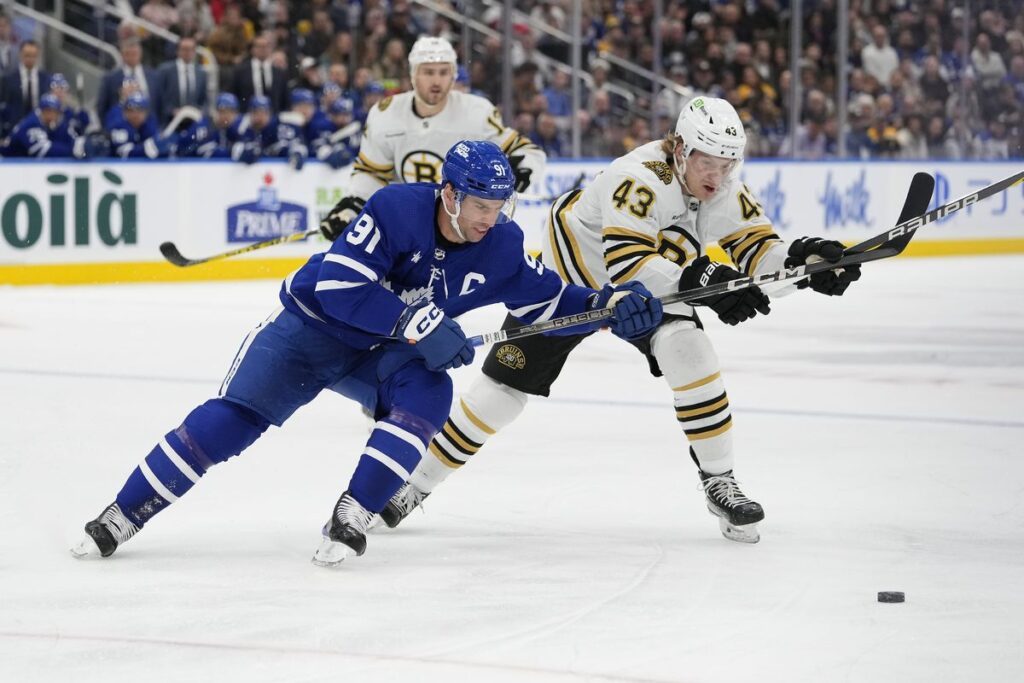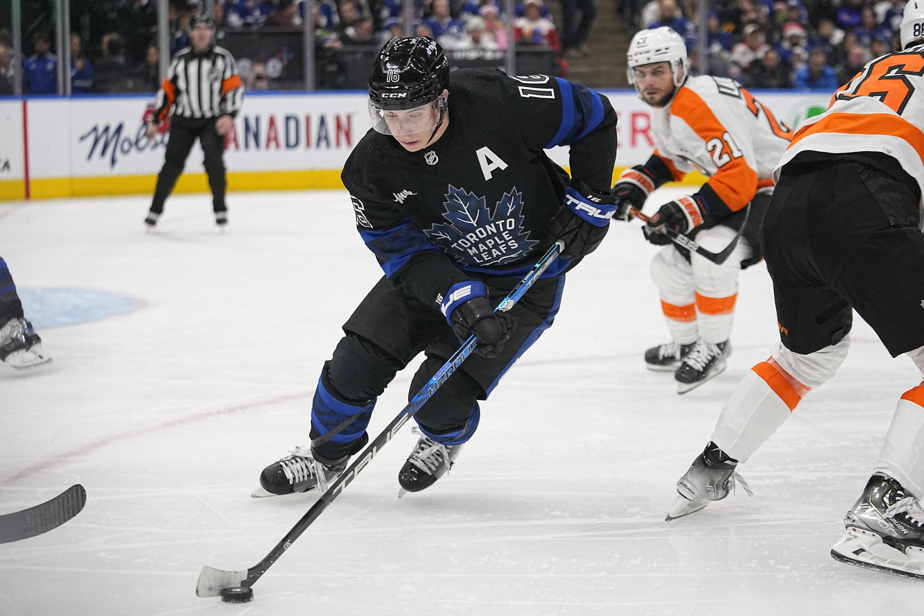As we review the current Maple Leafs under contract for 2024-25, next up in the Offseason Evaluations series are Mitch Marner and John Tavares, two $11 million players entering the final year of their contracts.
In case you missed it, I reviewed Auston Matthews and William Nylander‘s 2023-24 seasons and the expectations entering 2024-25 in Part 1.
Mitch Marner

| Mitch Marner | |
|---|---|
| 2023-24 Production | 26 goals and 85 points in 69 games (21:17 per game) |
| 5v5 Results | 53.69 CF% | 52.89 xGF% | 56 goals for, 37 goals against |
| Contract Status | One year remaining at $10.9 million AAV (NMC) |
We have already started discussing the decisions the Leafs face regarding Marner as he enters the last season of his contract, so I do not want to rehash all of it here. Instead, I will go through his 2023-24 season.
It is important to note a few key facts. Not only did Marner drive play well, but unlike Matthews, he was on for far fewer goals against at 5v5, and unlike Nylander, he was actually on for more goals for than against in general. The Leafs may have already decided to go with those two players and move Marner, given each contract situation as things stand today. Still, it is important to note that Marner was a significant contributor to regular-season success.
Marner experienced a slower start to the season by his standards, with eight points in nine games in October. Over the next four months, though, he piled up 65 points in 49 games, and much like Matthews and Nylander, he produced a big February with 20 points as the Leafs cemented their playoff berth.
The Matthews-Marner combination really went off at 5v5 in February; Marner only recorded six of his 20 points on the power play. At this point in the season, he had largely played with Matthews. Tyler Bertuzzi was on their wing to start the season, but it didn’t click. Eventually, Matthew Knies made his way onto the line. While Knies is a good young player learning the league, Matthews and Marner were playing big, top-line minutes and roles with what ended up being a 35-point player on the other side of the ice.
Fresh off Marner’s best month of the season, he was hurt in March, and the team went a modest 7-4-1 in his absence (which tied with Minnesota for 11th in the league in points percentage over that time). The Leafs are 20-17-5 all-time without Marner, for what it’s worth. While he was injured, the Bertuzzi – Matthews – Domi line somewhat emerged, at least enough to give the Leafs more intriguing depth options, and so they spread out their top three players across three lines. For Marner, it meant he was on a line with McMann and Tavares. In that month, Marner racked up nine points in eight games.
The playoffs were a different story, though. The series started with Nylander out, followed by Matthews, while Marner’s linemate to end the season, McMann, never played a playoff game due to injury. Marner was moved around all over the place as a result, playing with Tavares and Knies as well as Bertuzzi and Domi. He recorded just three points in the seven-game series, the power play was awful – of which he was a central figure – and his one goal came in a Game 5 loss that was all but decided at the time. I will note that in Game 5, with the season on the line, I thought Marner’s line with Bertuzzi and Domi was the team’s best in the game.
Marner’s role on the penalty kill this season should also be noted. Sheldon Keefe used him come hell or high water on the top penalty-killing unit, but it looked its best when Marner was out and Connor Dewar was promoted. When Marner returned from injury, he walked right back onto the top unit and the penalty kill stumbled, leading to a bad playoff.
Marner was on for four of the Leafs‘ six goals allowed on the penalty kill in the Bruins series. He appeared to be attempting to methodically outhink opposing power plays rather than aggressively pressuring (something Dewar, for example, did well with his speed). Marner has been part of good penalty-killing units before and has been a good penalty killer before, but this was a really poor year for him shorthanded, and neither the Leafs – nor Marner himself – ever adjusted. It was a major problem.
Overall, this was the worst season for the Matthews-Marner duo since Sheldon Keefe was hired mid-season in 2019-20 and combined the pair. Their possession numbers took a dip, and they posted their lowest goals for percentage across four full seasons of playing together (although, last season, Marner split time evenly between Matthews and Tavares):
| Matthews - Marner | Goals for | Goals against | Goals for percentage |
|---|---|---|---|
| 2023-2024 | 43 | 28 | 60.56% |
| 2022-2023 | 33 | 20 | 62.26% |
| 2021-2022 | 66 | 39 | 62.86 |
| 2020-2021 | 49 | 23 | 68.06 |
These results came with Matthews recording a historic season.
There are a lot of theories as to why they experienced a slight dip, but the most straightforward answer is that the pieces around them were a little worse. Michael Bunting was far more productive than Matthew Knies (Bunting scored back-to-back 23 goal seasons, Knies scored 15). TJ Brodie’s game completely fell, with the knock-on effect of making Morgan Rielly worse as well. It took Sheldon Keefe nearly 50 games to figure out how to use other players on the roster in general, putting more responsibility on Matthews and Marner in the meantime. Simply acquiring a proper right-handed defenseman to pair with Rielly and form a five-man unit with Matthews and Marner, along with a modest second-year bump from Knies, would drastically improve the environment around Matthews and Marner.
This is not to suggest that the two were perfect and it is everyone else’s fault. Matthews and Marner combined to make over $22 million last season and are supposed to carry the mail. But compare their environment to someone like Connor McDavid, who most commonly played with Zach Hyman, Evan Bouchard, Mattias Ekholm, Ryan Nugent-Hopkins, and Leon Draisaitl, or Nathan MacKinnon, who has Mikko Rantanen and probably the best defense pairing in the league generally supporting him. A Rielly-Brodie pairing and a rookie Matthew Knies pale by comparison.
In January of last season, the Leafs lost to the Avalance at home as the MacKinnon line had its way in the head-to-head matchup against the Leafs’ top line of Knies – Matthews – Marner plus the Rielly-Brodie pairing, leading Keefe to shift Nylander onto a loaded-up line of Nylander – Matthews – Marner. Keefe said after the game, “When MacKinnon’s line is out there with Makar and Toews, the calibre of play is not the NHL. It is another league. I didn’t think we were handling that very well.”
Either Leafs brass needs to upgrade the top of the lineup and blitz teams with their big duo, or they need to spread them out to create three dangerous lines, one driven by each star who they pay handsomely.
John Tavares

| John Tavares | |
|---|---|
| 2023-24 Production | 29 goals and 65 points in 80 games (17:52 per game) |
| 5v5 Results | 52.02 CF% | 54.60 xGF% | 50 goals for, 41 goals against |
| Contract Status | One year remaining at $11 million AAV (NMC) |
From the second Tavares signed his big contract in Toronto, it was always assumed that the final few years of his deal would be tough to swallow. The trade-off was meant to be that the team would win a Cup at some point in the first half. Obviously, that didn’t happen (not even close), and the Leafs are left to weather the final few years of Tavares’ contract, which is down to its last year now. The captain is now a still good but overpaid player.
Tavares got off to a strong start this season. As mentioned, the Bertuzzi – Tavares – Nylander line was easily the Leafs’ best for the first few months, and Tavares finished October with 12 points in nine games, which was second on the team in the month. In November, he produced eight points in 12 games, followed by a strong December in which he posted 11 in 13.
January was a tough month for Tavares, though, as he tallied just four points in 13 games and battled a 10-game goalless drought. The All-Star break rolled around in February, and the rest and reset served him well. Following the All-Star break, Tavares piled up 30 points in 33 games (after 35 in 47 before then).
Tavares’ strong second half also coincided with him shifting around the lineup a little more. He wasn’t stapled to the second-line center spot, spending long stretches centering a third line to tilt the matchups with players like Matthew Knies, Bobby McMann, and Nick Robertson. When Marner got hurt in March, Tavares moved up to center Nylander and McMann, a line that also performed well. Tavares wasn’t only more productive in the second half of the season; he was also playing under a minute less compared to the first half. It is something to be mindful of, as Tavares will be 34 by the time next season starts.
This season, Tavares actually posted the worst shooting percentage of his entire career (and still scored 29 goals). It was also his lowest points-per-game mark since his rookie season. How much it will bounce back compared to the natural decline that comes with the aging curve is yet to be determined. There is reason to believe Tavares should at least remain a solid point producer in 2024-25, though.
The tricky part is that the Leafs can’t necessarily rely on Tavares as a line-driving force. In the 2023 playoffs, the Leafs entered the second round and tried to match Tavares and Marner against the Bennett-Tkachuk duo. The experiment lasted all of one period.
In this season’s playoffs, Tavares recorded just two points in seven games. One point was a broken play, and the other was a genuinely nice play to drive the puck to the net, leading to Knies’ overtime winner. He put 22 shots on net in the series, but the number is a bit deceiving as Tavares was out-attempted and out-chanced at 5v5. It was a slog of a series overall – no Leaf really pushed through the Bruins’ defensive shell – but Tavares is still relied on offensively and was part of the issue.
Similarly, Tavares was taken off the power play throughout the second half of the season—the team enjoyed a record-setting February with Bertuzzi often in his place—before the Leafs once again struggled in the playoffs on the man advantage, which Tavares was a large part of.
There has been a clear gap between the Leafs’ top two centers and bottom two centers since the organization traded Nazem Kadri. That has been fine for regular-season success most of the time because Tavares was generally a point-per-game player. However, with a slight step back in 2023, it creates a domino effect throughout the lineup. I don’t think it was a coincidence that the Leafs looked their most dangerous as an overall team when Tavares moved to the third line to make them a legitimate scoring threat while Nylander drove the second line offensively.
In the bigger picture, the ideal scenario is that the Leafs acquire another center that allows Tavares to play on a third line with favourable matchups and linemates (such as Bobby McMann, potentially Easton Cowan), as he’s still clearly a productive player.
We’re all aware that Tavares will be overpaid this season, but he’s still a useful player. He can produce, he’s one of the better faceoff men in the league, and he started to show this season that he can play with younger, inexperienced players such as McMann and Robertson and help bring them along. The Leafs have to make the best of the situation, but Tavares is not a totally crippling and net-negative presence on the roster, either.
Next up in the Offseason Evaluations series: David Kampf & Calle Jarnkrok

































